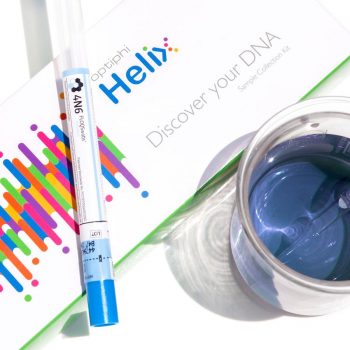Anyone who has read the October issue of Woman&Home will know that I am terrified of breast cancer. It has a strong, ever-present relationship with many of the women in my family, and it’s starting to feel like something of an inevitable future for me. I know that sounds really sombre, but I like to think of it more as being a realist. And part of being a realist means that I can do certain things now, at the age of 36, that could save my life down the line.
So when I got the chance to try the Optiphi Helix Breast Cancer Test, I was equal parts terrified (Procrastination Heather made an appearance in replying to that email) and encouraged, because any knowledge about your health is power.
HOW IT WORKS
The process couldn’t be simpler. Optiphi sends you a little kit, which includes a short form (don’t worry, you’re not selling your first born, it’s a very short form) and a long swab. After not eating or drinking for 30 minutes, you swab the inside of your mouth for about a minute, then place the swab back inside its plastic wand. Close up the box and wait for the Optiphi courier to collect your box, spit and DNA. A few weeks later, I received the reports and scheduled a Zoom meeting with Khilona Natha, one of the geneticists at Optiphi, to discuss them.

THE RESULTS
First of all, a disclaimer: It’s important to understand that there are several risk factors involved in breast, ovarian and prostate cancer, with genetics contributing only a portion to overall susceptibility. ‘The report is not a diagnosis, it’s just looking at genetically what your risk is. With cancer, it’s quite multifactorial, and there are a lot of things that one needs to consider, like lifestyle, family history and exposure to oestrogen. This report is working in conjunction with those factors,’ says Khilona.
‘I can only speak from a genetics point of view. What the reports tell you in your intrinsic risk for whatever health conditions we’re addressing in that specific report,’ she says. ‘We aim to create an awareness with our reports so that you can then discuss this with your medical practitioner, and they would be able to organise a treatment plan or address certain things right away.’
And with that (and me waiting on tenterhooks), we move into the nicely summarised part of the report, which breaks down my results into the following:
BRCAI (BREAST CANCER TYPE 1 SUSCEPTIBILITY GENE)
A heterozygous mutation (GIn356Arg) was found in your BRCA I gene and has been associated with an increased risk for breast and ovarian cancer
A heterozygous mutation (Ser1613Cys) was found in your BRCA I gene and has been associated with an increased risk for breast and ovarian cancer
BRCA2 (BREAST CANCER TYPE 2 SUSCEPTIBILITY GENE)
No mutations were found in the BRCA2 gene with regards to the panel of markers that were screened
TP53 (TUMOUR PROTEIN)
No mutations were found in the TP53 gene with regards to the panel of markers that were screened
ODDS RATIO: 2.07 (LOW RISK)
Based on the genetic odds ratio, it is suggested that the patient has a low genetic risk for breast cancer (secondarily ovarian and prostate cancer). If they present with additional risk factors consider more regular screenings and other preventative measures.
INTERPRETATION
After chatting through these results with Khilona, I breathe a sigh of relief. It’s not forecasting my future, I know, but it’s also not as bad as I was expecting. I was waiting for red flags to pop up from every corner. The report was a stark reminder that when it comes to cancer, there are certain things that are very much out of our control, but there are also things within our control. ‘There are external influences that need to be considered, like the environment, your lifestyle, your diet, family history. This is just purely what your genes are telling you, so that doesn’t necessarily mean that what is stated in the report will develop. It’s telling you genetically that you carry certain risk variants and it’s something to keep in mind,’ says Khilona.
Yes, I show certain mutations that are associated with an increased risk of breast cancer, and that’s okay, because armed with that information, I can tailor and tweak everything in my realm of control to make sure that I stay on top of it. I feel more motivated than ever not to shy away from the big ‘C’ word, but rather to face it head-on. It’s not a diagnosis I just need to sit back and wait to fall in my lap, but rather something I can actively start preventing now.
Now excuse me while I go off and book my first mammogram…
For more, visit https://optiphi.com/.

